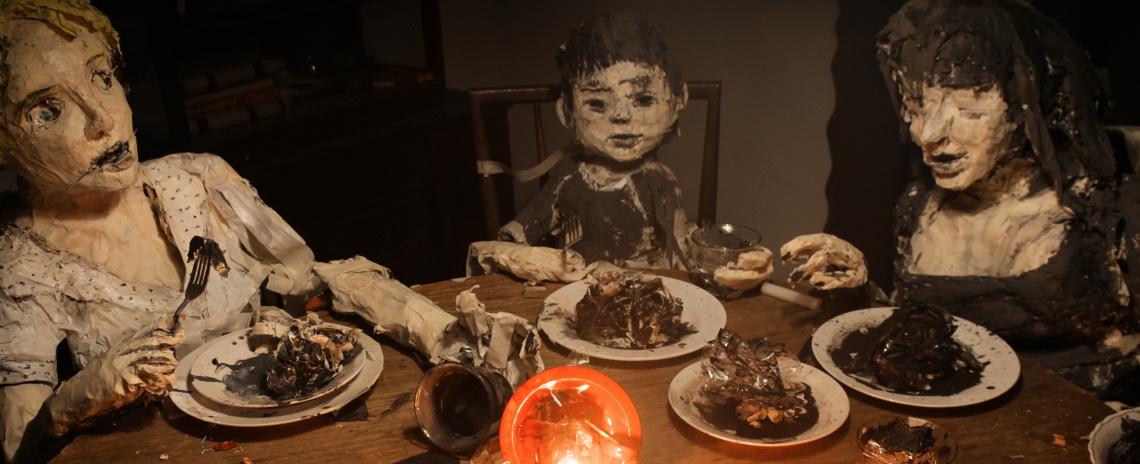In 1961, a German emigrant named Paul Schäfer founded the Colonia Dignidad (“Dignity Colony”) in the Maule Region of central Chile. A self-styled Christian preacher, shameless con artist, and serial pedophile, Schäfer established the colony as a strictly isolated enclave for his own fiendish cult of personality, one cast from the same mold as Jim Jones’ People’s Temple. Besides functioning as a de facto prison for colony members and fostering the systemic sexual abuse of children, Dignity Colony eventually became an eager collaborator with the regime of Augusto Pinochet, serving as a secret detention and torture facility for the right-wing Chilean dictator. It’s a story so twisted and monstrous that survivors, NGOs, and the Chilean government are still reckoning with its aftershocks to this day.
The story told in the new animated film The Wolf House is not exactly the story of Schäfer and Dignity Colony. The film – the astonishing, profoundly disturbing debut feature from multimedia artists Joaquín Cociña and Cristóbal León – spins a darkling fairy tale that is best described as a story that sprouts perpendicular to the real-world colony’s history. It is a boldly hand-crafted hallucination inspired by the evils wrought by Schäfer (and all men like him). The film’s subject is not the violations themselves, but the resulting terror that echoes through the decades, corrupting everything with its discordant vibrations. It’s one part early David Lynch short, one part Bruce Bickford stop-motion film, and one part crypto-Nazi ayahuasca nightmare. Like most nightmares, The Wolf House doesn’t have a narrative so much as its own liquid, ruthless anti-logic. The experience is akin to an out-of-control tumble down through the disparate layers of Hell, each one blurring into the next.
The Wolf House imagines a young woman, Maria (voiced by Amalia Kassai), a wayward dreamer who escapes Dignity Colony and establishes her own private sanctuary in a vacant house deep in the wilderness. She fashions this place into a twee little hideaway for herself, complete with framed pictures on the walls, coats hanging neatly on hooks, and a stuffed armchair in front of a television blaring her favorite programs. Maria befriends two pigs – one stout female, one runty male – and, through what can only be described as dream logic, she bestows them with anthropomorphic features and gives them Christmas gifts of human clothes. Gradually these pig-people, Ana and Pedro, evolve to resemble idealized Aryan children, helped along in their transformation by the doses of magical honey that Maria provides.
Contrary to the lessons taught by children’s books and horror movies regarding abandoned cabins, Maria’s would-be haven does not conceal a secret evil. Rather, the true threat lies in what Maria has brought with her: the bizarre fears that gnaw at her mind, the twisted dogma that provokes her compulsions, and the ravenous power that prowls the wilds outside her door. Evoking fragments from “The Three Little Pigs,” “Little Red Riding Hood,” and “Hansel & Gretel,” The Wolf House serves up a surreal Grimm Brothers variation on the perverse upheavals and reversals that are endemic to psychological-horror cinema. It’s not just that the calls are coming from inside the house. It’s that the wolf is both within and without, both reviled and needed. It’s the dread possibility that I might have been the wolf all along.
As intriguingly weird as this might sound, the most immediately striking thing about The Wolf House is not its story but the remarkable method of its construction. Reportedly shot over the course of six years in public-exhibition spaces around Latin America and Europe, the film uses the distinctive stop-motion approach the directors employed in their acclaimed short film “Lucía.” What the Brothers Quay craft in miniature, Cociña and León construct on a human-sized scale, incorporating elements of painting, sculpture, and installation. Their technique involves the manipulation of real-world objects and large puppets within constructed spaces, as well as a truly heroic quantity of painting, re-painting, and re-re-painting. Such descriptions do not do the overall effect justice, however. One must see the film’s uncanny, nightmarish visuals to understand how inimitable (and disturbing) they truly are: the way that Maria’s dreamy narration seems to cover the walls with squirming tendrils of paint; the way that the grotesque papier-mâché figures wobble through the film’s stuttering half-light; the way that materials such as crumpled cellophane, insulation foam, and concrete rubble seem to scuttle like swarms of vermin.
The impact of this animation method is, in a word, creepy, driving home the notion that the story is unfolding in the twilight realm of dreams. (Granted, it’s not as if the feverishly shifting corridors and disembodied heads were insufficiently convincing on this point.) In those instances where the real intrudes into this unreal space, it seems designed to elicit alarm and unease: Blink and you might miss the swastika that flickers in and out of sight as Maria’s thoughts sketch a four-paned window on the wall. Ultimately, however, brazen symbolism is less important to The Wolf House’s aims than the oppressive yet intoxicating sensations that the film elicits. It’s a bit like a 75-minute walking tour through an abuse survivor’s memory palace, a domain as filthy and chaotic as the serial-killer dreamscapes in The Cell (2000) were music-video slick. Dignity Colony might only appear in the feature’s brief, mockumentary prelude, but it is always present, just as it is within Maria’s mind. It curdles what was already an off-key mockery of nuclear-family domesticity into something even more sinister, setting up a reversal to rival that of Veronika Franz and Severin Fiala’s diabolical Goodnight Mommy (2014). The result is a deeply unsettling depiction of the way that trauma clings and oozes like a cancerous fluid, endlessly filling new vessels and assuming new shapes.
Rating: B+
The Wolf House is now available to rent from major online platforms.


